Exploring HIV Prevalence and Contributing Factors Among Kenyan Youths
VerifiedAdded on 2022/12/18
|8
|2361
|53
Essay
AI Summary
This essay provides a comprehensive analysis of HIV infection among youths in Kenya. It explores the biological causes, including the high transmissibility of HIV and the vulnerability of adolescent bodies. The essay also examines psychosocial factors such as lack of knowledge and social stigma, as well as the impact of poor social support. Furthermore, it delves into the political and economic factors that contribute to the high prevalence of HIV, including governmental policies and the high costs of treatment. The essay concludes by emphasizing the need for a multi-faceted approach to address the issue, considering biological, social, and economic aspects to effectively prevent and treat HIV among Kenyan youths. The essay highlights the importance of education, social support, and economic empowerment in mitigating the spread of the disease.

Running head: STI AMONG YOUTHS OF AUSTRALIA
STI among Youths of Australia
Name of the Student
Name of the University
Author Note
STI among Youths of Australia
Name of the Student
Name of the University
Author Note
Paraphrase This Document
Need a fresh take? Get an instant paraphrase of this document with our AI Paraphraser
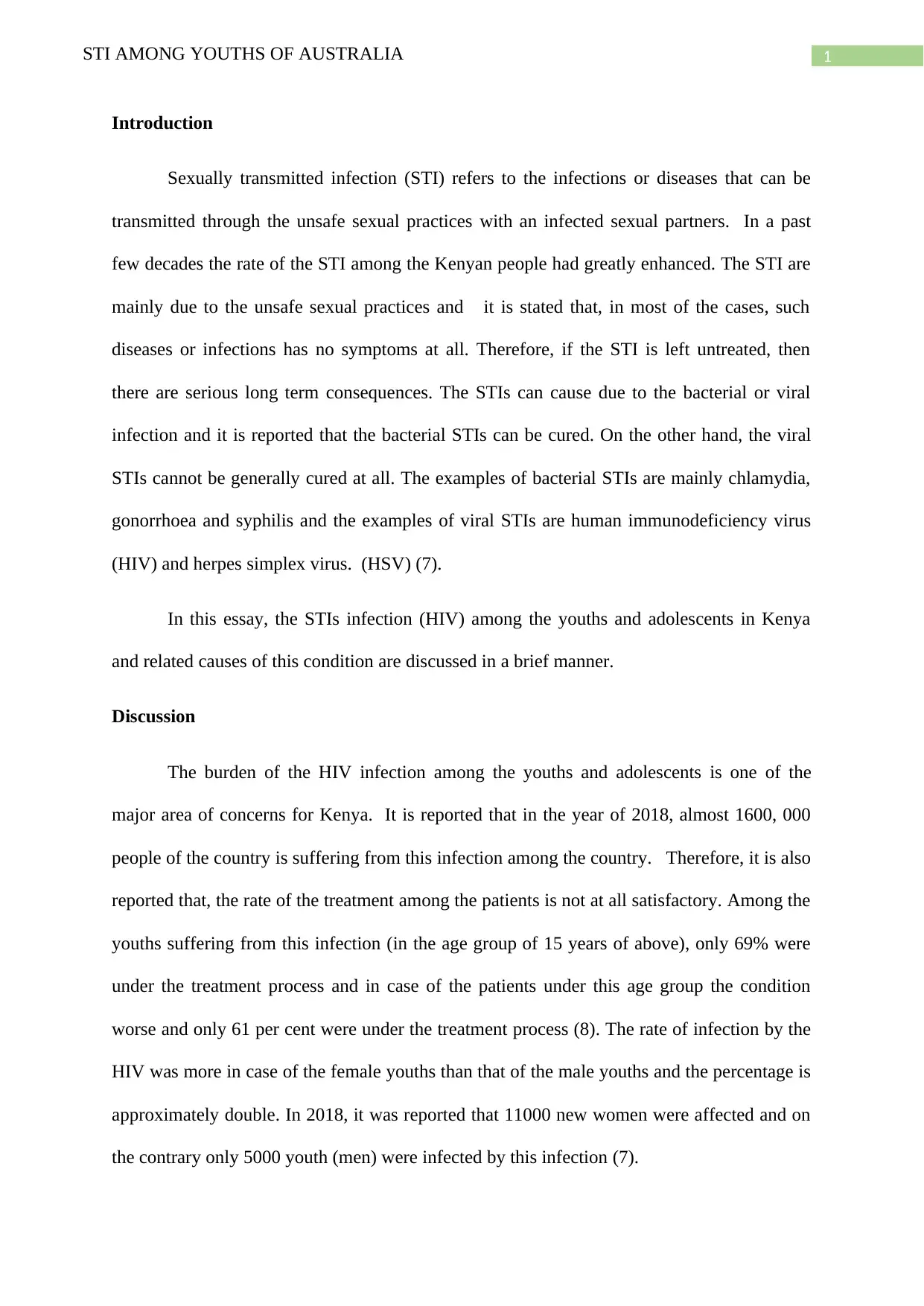
1STI AMONG YOUTHS OF AUSTRALIA
Introduction
Sexually transmitted infection (STI) refers to the infections or diseases that can be
transmitted through the unsafe sexual practices with an infected sexual partners. In a past
few decades the rate of the STI among the Kenyan people had greatly enhanced. The STI are
mainly due to the unsafe sexual practices and it is stated that, in most of the cases, such
diseases or infections has no symptoms at all. Therefore, if the STI is left untreated, then
there are serious long term consequences. The STIs can cause due to the bacterial or viral
infection and it is reported that the bacterial STIs can be cured. On the other hand, the viral
STIs cannot be generally cured at all. The examples of bacterial STIs are mainly chlamydia,
gonorrhoea and syphilis and the examples of viral STIs are human immunodeficiency virus
(HIV) and herpes simplex virus. (HSV) (7).
In this essay, the STIs infection (HIV) among the youths and adolescents in Kenya
and related causes of this condition are discussed in a brief manner.
Discussion
The burden of the HIV infection among the youths and adolescents is one of the
major area of concerns for Kenya. It is reported that in the year of 2018, almost 1600, 000
people of the country is suffering from this infection among the country. Therefore, it is also
reported that, the rate of the treatment among the patients is not at all satisfactory. Among the
youths suffering from this infection (in the age group of 15 years of above), only 69% were
under the treatment process and in case of the patients under this age group the condition
worse and only 61 per cent were under the treatment process (8). The rate of infection by the
HIV was more in case of the female youths than that of the male youths and the percentage is
approximately double. In 2018, it was reported that 11000 new women were affected and on
the contrary only 5000 youth (men) were infected by this infection (7).
Introduction
Sexually transmitted infection (STI) refers to the infections or diseases that can be
transmitted through the unsafe sexual practices with an infected sexual partners. In a past
few decades the rate of the STI among the Kenyan people had greatly enhanced. The STI are
mainly due to the unsafe sexual practices and it is stated that, in most of the cases, such
diseases or infections has no symptoms at all. Therefore, if the STI is left untreated, then
there are serious long term consequences. The STIs can cause due to the bacterial or viral
infection and it is reported that the bacterial STIs can be cured. On the other hand, the viral
STIs cannot be generally cured at all. The examples of bacterial STIs are mainly chlamydia,
gonorrhoea and syphilis and the examples of viral STIs are human immunodeficiency virus
(HIV) and herpes simplex virus. (HSV) (7).
In this essay, the STIs infection (HIV) among the youths and adolescents in Kenya
and related causes of this condition are discussed in a brief manner.
Discussion
The burden of the HIV infection among the youths and adolescents is one of the
major area of concerns for Kenya. It is reported that in the year of 2018, almost 1600, 000
people of the country is suffering from this infection among the country. Therefore, it is also
reported that, the rate of the treatment among the patients is not at all satisfactory. Among the
youths suffering from this infection (in the age group of 15 years of above), only 69% were
under the treatment process and in case of the patients under this age group the condition
worse and only 61 per cent were under the treatment process (8). The rate of infection by the
HIV was more in case of the female youths than that of the male youths and the percentage is
approximately double. In 2018, it was reported that 11000 new women were affected and on
the contrary only 5000 youth (men) were infected by this infection (7).
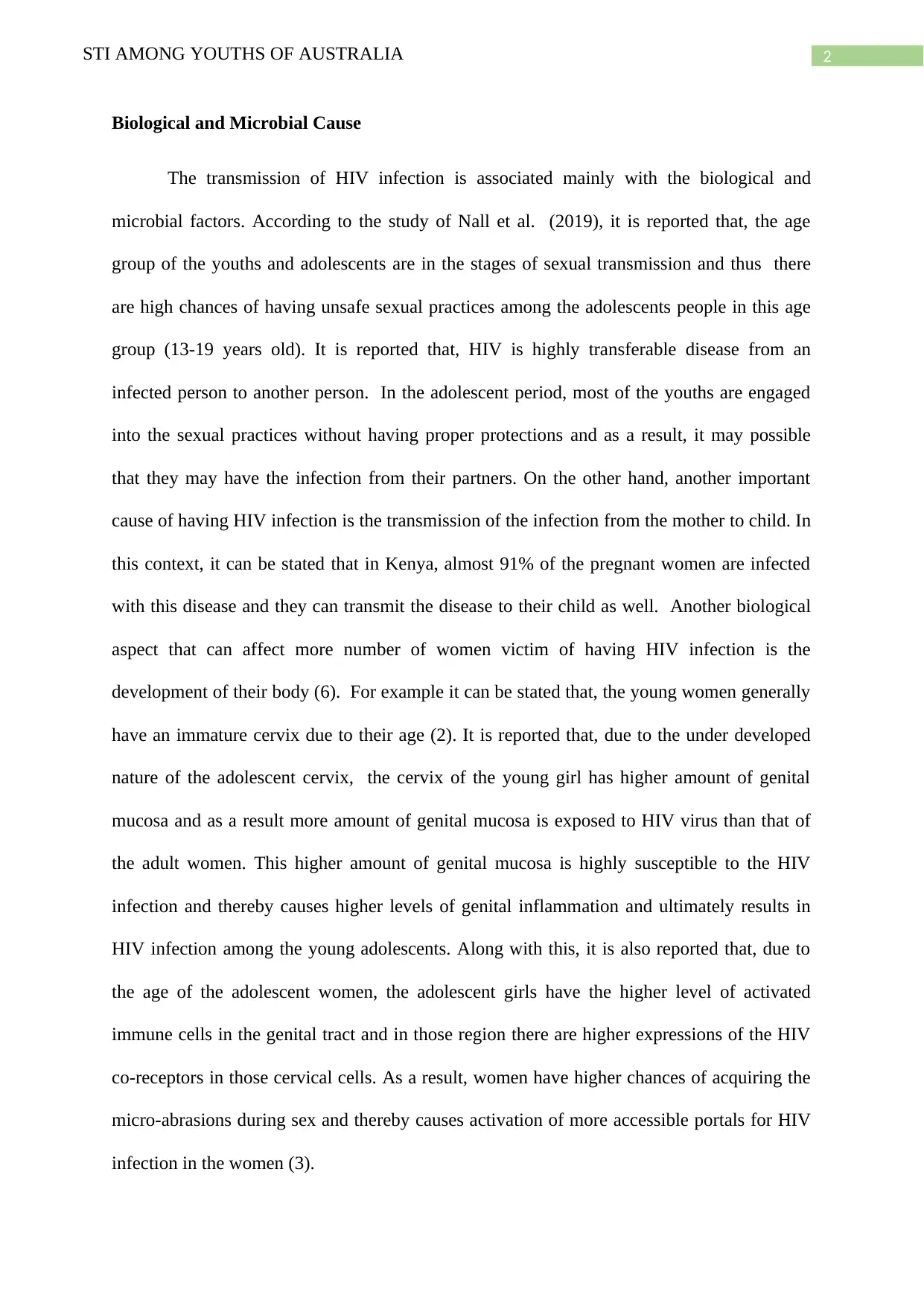
2STI AMONG YOUTHS OF AUSTRALIA
Biological and Microbial Cause
The transmission of HIV infection is associated mainly with the biological and
microbial factors. According to the study of Nall et al. (2019), it is reported that, the age
group of the youths and adolescents are in the stages of sexual transmission and thus there
are high chances of having unsafe sexual practices among the adolescents people in this age
group (13-19 years old). It is reported that, HIV is highly transferable disease from an
infected person to another person. In the adolescent period, most of the youths are engaged
into the sexual practices without having proper protections and as a result, it may possible
that they may have the infection from their partners. On the other hand, another important
cause of having HIV infection is the transmission of the infection from the mother to child. In
this context, it can be stated that in Kenya, almost 91% of the pregnant women are infected
with this disease and they can transmit the disease to their child as well. Another biological
aspect that can affect more number of women victim of having HIV infection is the
development of their body (6). For example it can be stated that, the young women generally
have an immature cervix due to their age (2). It is reported that, due to the under developed
nature of the adolescent cervix, the cervix of the young girl has higher amount of genital
mucosa and as a result more amount of genital mucosa is exposed to HIV virus than that of
the adult women. This higher amount of genital mucosa is highly susceptible to the HIV
infection and thereby causes higher levels of genital inflammation and ultimately results in
HIV infection among the young adolescents. Along with this, it is also reported that, due to
the age of the adolescent women, the adolescent girls have the higher level of activated
immune cells in the genital tract and in those region there are higher expressions of the HIV
co-receptors in those cervical cells. As a result, women have higher chances of acquiring the
micro-abrasions during sex and thereby causes activation of more accessible portals for HIV
infection in the women (3).
Biological and Microbial Cause
The transmission of HIV infection is associated mainly with the biological and
microbial factors. According to the study of Nall et al. (2019), it is reported that, the age
group of the youths and adolescents are in the stages of sexual transmission and thus there
are high chances of having unsafe sexual practices among the adolescents people in this age
group (13-19 years old). It is reported that, HIV is highly transferable disease from an
infected person to another person. In the adolescent period, most of the youths are engaged
into the sexual practices without having proper protections and as a result, it may possible
that they may have the infection from their partners. On the other hand, another important
cause of having HIV infection is the transmission of the infection from the mother to child. In
this context, it can be stated that in Kenya, almost 91% of the pregnant women are infected
with this disease and they can transmit the disease to their child as well. Another biological
aspect that can affect more number of women victim of having HIV infection is the
development of their body (6). For example it can be stated that, the young women generally
have an immature cervix due to their age (2). It is reported that, due to the under developed
nature of the adolescent cervix, the cervix of the young girl has higher amount of genital
mucosa and as a result more amount of genital mucosa is exposed to HIV virus than that of
the adult women. This higher amount of genital mucosa is highly susceptible to the HIV
infection and thereby causes higher levels of genital inflammation and ultimately results in
HIV infection among the young adolescents. Along with this, it is also reported that, due to
the age of the adolescent women, the adolescent girls have the higher level of activated
immune cells in the genital tract and in those region there are higher expressions of the HIV
co-receptors in those cervical cells. As a result, women have higher chances of acquiring the
micro-abrasions during sex and thereby causes activation of more accessible portals for HIV
infection in the women (3).
⊘ This is a preview!⊘
Do you want full access?
Subscribe today to unlock all pages.

Trusted by 1+ million students worldwide
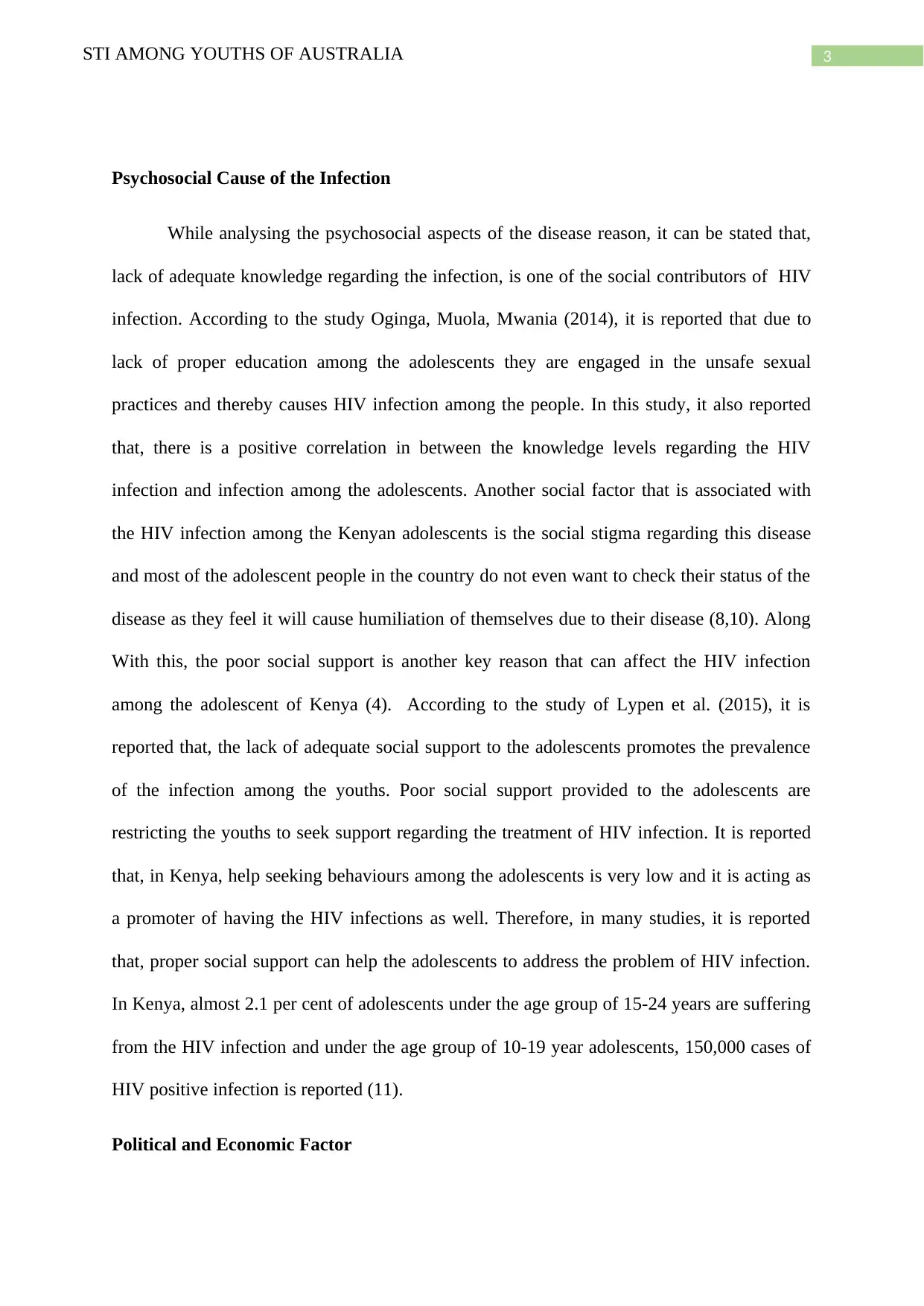
3STI AMONG YOUTHS OF AUSTRALIA
Psychosocial Cause of the Infection
While analysing the psychosocial aspects of the disease reason, it can be stated that,
lack of adequate knowledge regarding the infection, is one of the social contributors of HIV
infection. According to the study Oginga, Muola, Mwania (2014), it is reported that due to
lack of proper education among the adolescents they are engaged in the unsafe sexual
practices and thereby causes HIV infection among the people. In this study, it also reported
that, there is a positive correlation in between the knowledge levels regarding the HIV
infection and infection among the adolescents. Another social factor that is associated with
the HIV infection among the Kenyan adolescents is the social stigma regarding this disease
and most of the adolescent people in the country do not even want to check their status of the
disease as they feel it will cause humiliation of themselves due to their disease (8,10). Along
With this, the poor social support is another key reason that can affect the HIV infection
among the adolescent of Kenya (4). According to the study of Lypen et al. (2015), it is
reported that, the lack of adequate social support to the adolescents promotes the prevalence
of the infection among the youths. Poor social support provided to the adolescents are
restricting the youths to seek support regarding the treatment of HIV infection. It is reported
that, in Kenya, help seeking behaviours among the adolescents is very low and it is acting as
a promoter of having the HIV infections as well. Therefore, in many studies, it is reported
that, proper social support can help the adolescents to address the problem of HIV infection.
In Kenya, almost 2.1 per cent of adolescents under the age group of 15-24 years are suffering
from the HIV infection and under the age group of 10-19 year adolescents, 150,000 cases of
HIV positive infection is reported (11).
Political and Economic Factor
Psychosocial Cause of the Infection
While analysing the psychosocial aspects of the disease reason, it can be stated that,
lack of adequate knowledge regarding the infection, is one of the social contributors of HIV
infection. According to the study Oginga, Muola, Mwania (2014), it is reported that due to
lack of proper education among the adolescents they are engaged in the unsafe sexual
practices and thereby causes HIV infection among the people. In this study, it also reported
that, there is a positive correlation in between the knowledge levels regarding the HIV
infection and infection among the adolescents. Another social factor that is associated with
the HIV infection among the Kenyan adolescents is the social stigma regarding this disease
and most of the adolescent people in the country do not even want to check their status of the
disease as they feel it will cause humiliation of themselves due to their disease (8,10). Along
With this, the poor social support is another key reason that can affect the HIV infection
among the adolescent of Kenya (4). According to the study of Lypen et al. (2015), it is
reported that, the lack of adequate social support to the adolescents promotes the prevalence
of the infection among the youths. Poor social support provided to the adolescents are
restricting the youths to seek support regarding the treatment of HIV infection. It is reported
that, in Kenya, help seeking behaviours among the adolescents is very low and it is acting as
a promoter of having the HIV infections as well. Therefore, in many studies, it is reported
that, proper social support can help the adolescents to address the problem of HIV infection.
In Kenya, almost 2.1 per cent of adolescents under the age group of 15-24 years are suffering
from the HIV infection and under the age group of 10-19 year adolescents, 150,000 cases of
HIV positive infection is reported (11).
Political and Economic Factor
Paraphrase This Document
Need a fresh take? Get an instant paraphrase of this document with our AI Paraphraser
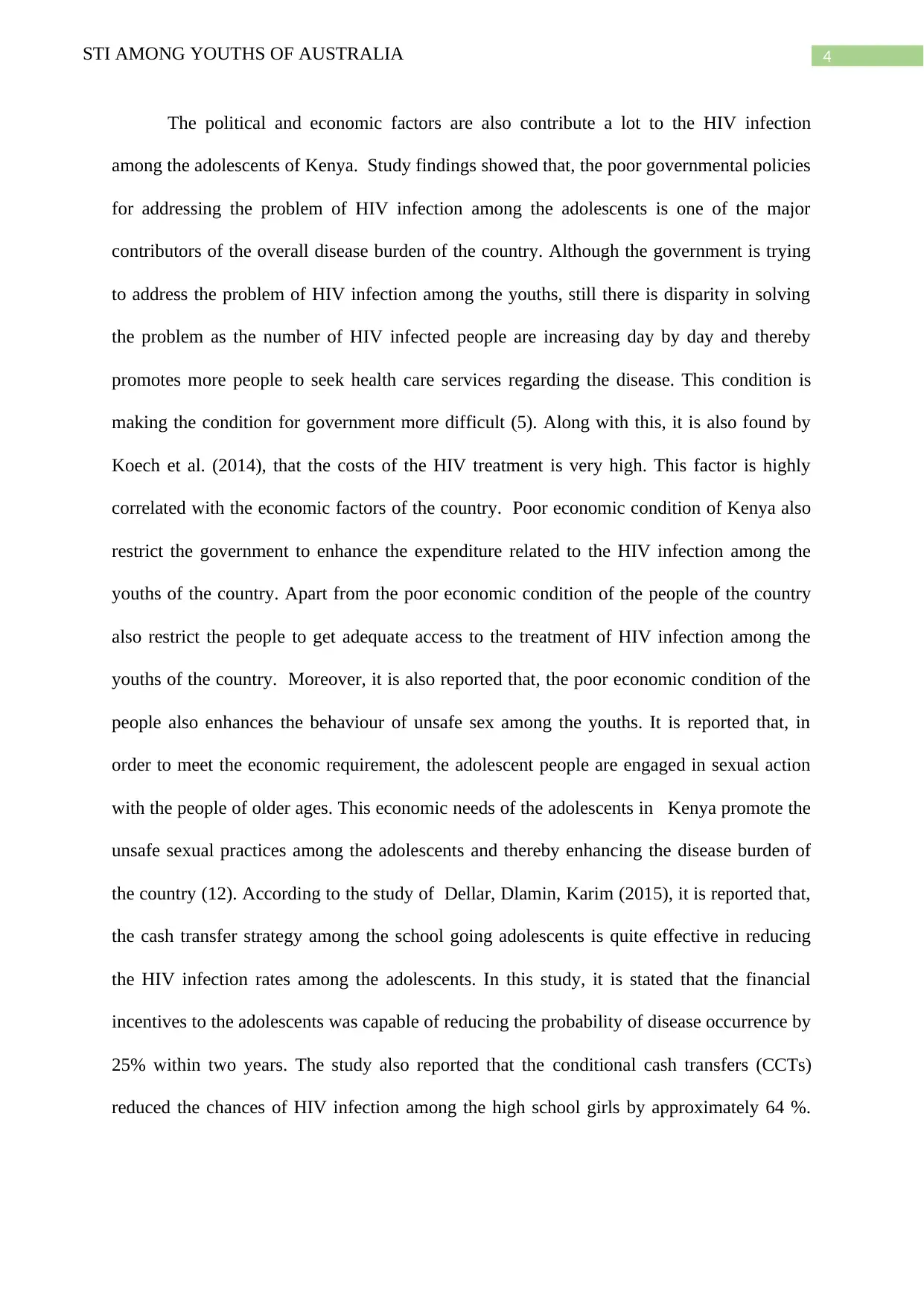
4STI AMONG YOUTHS OF AUSTRALIA
The political and economic factors are also contribute a lot to the HIV infection
among the adolescents of Kenya. Study findings showed that, the poor governmental policies
for addressing the problem of HIV infection among the adolescents is one of the major
contributors of the overall disease burden of the country. Although the government is trying
to address the problem of HIV infection among the youths, still there is disparity in solving
the problem as the number of HIV infected people are increasing day by day and thereby
promotes more people to seek health care services regarding the disease. This condition is
making the condition for government more difficult (5). Along with this, it is also found by
Koech et al. (2014), that the costs of the HIV treatment is very high. This factor is highly
correlated with the economic factors of the country. Poor economic condition of Kenya also
restrict the government to enhance the expenditure related to the HIV infection among the
youths of the country. Apart from the poor economic condition of the people of the country
also restrict the people to get adequate access to the treatment of HIV infection among the
youths of the country. Moreover, it is also reported that, the poor economic condition of the
people also enhances the behaviour of unsafe sex among the youths. It is reported that, in
order to meet the economic requirement, the adolescent people are engaged in sexual action
with the people of older ages. This economic needs of the adolescents in Kenya promote the
unsafe sexual practices among the adolescents and thereby enhancing the disease burden of
the country (12). According to the study of Dellar, Dlamin, Karim (2015), it is reported that,
the cash transfer strategy among the school going adolescents is quite effective in reducing
the HIV infection rates among the adolescents. In this study, it is stated that the financial
incentives to the adolescents was capable of reducing the probability of disease occurrence by
25% within two years. The study also reported that the conditional cash transfers (CCTs)
reduced the chances of HIV infection among the high school girls by approximately 64 %.
The political and economic factors are also contribute a lot to the HIV infection
among the adolescents of Kenya. Study findings showed that, the poor governmental policies
for addressing the problem of HIV infection among the adolescents is one of the major
contributors of the overall disease burden of the country. Although the government is trying
to address the problem of HIV infection among the youths, still there is disparity in solving
the problem as the number of HIV infected people are increasing day by day and thereby
promotes more people to seek health care services regarding the disease. This condition is
making the condition for government more difficult (5). Along with this, it is also found by
Koech et al. (2014), that the costs of the HIV treatment is very high. This factor is highly
correlated with the economic factors of the country. Poor economic condition of Kenya also
restrict the government to enhance the expenditure related to the HIV infection among the
youths of the country. Apart from the poor economic condition of the people of the country
also restrict the people to get adequate access to the treatment of HIV infection among the
youths of the country. Moreover, it is also reported that, the poor economic condition of the
people also enhances the behaviour of unsafe sex among the youths. It is reported that, in
order to meet the economic requirement, the adolescent people are engaged in sexual action
with the people of older ages. This economic needs of the adolescents in Kenya promote the
unsafe sexual practices among the adolescents and thereby enhancing the disease burden of
the country (12). According to the study of Dellar, Dlamin, Karim (2015), it is reported that,
the cash transfer strategy among the school going adolescents is quite effective in reducing
the HIV infection rates among the adolescents. In this study, it is stated that the financial
incentives to the adolescents was capable of reducing the probability of disease occurrence by
25% within two years. The study also reported that the conditional cash transfers (CCTs)
reduced the chances of HIV infection among the high school girls by approximately 64 %.
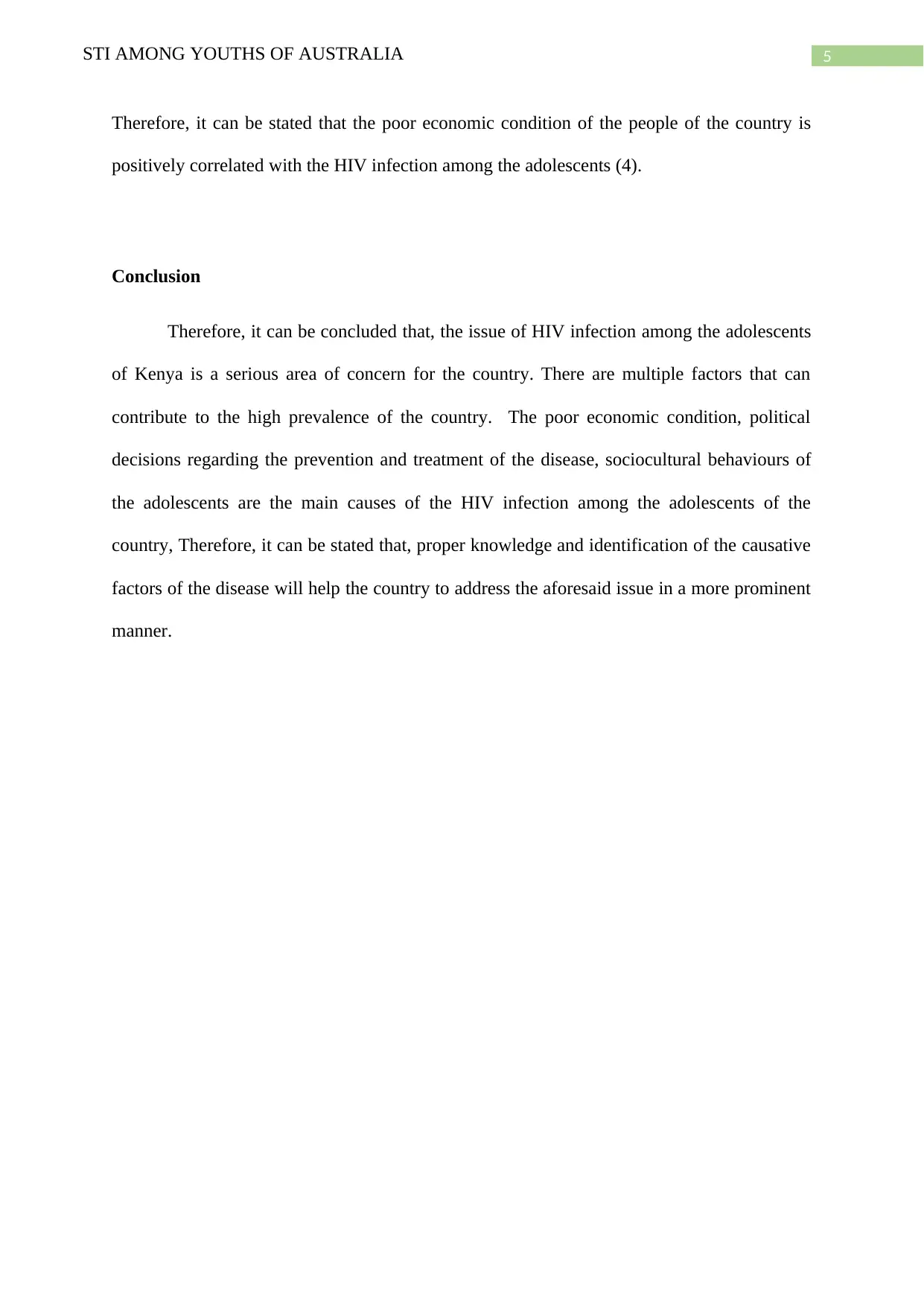
5STI AMONG YOUTHS OF AUSTRALIA
Therefore, it can be stated that the poor economic condition of the people of the country is
positively correlated with the HIV infection among the adolescents (4).
Conclusion
Therefore, it can be concluded that, the issue of HIV infection among the adolescents
of Kenya is a serious area of concern for the country. There are multiple factors that can
contribute to the high prevalence of the country. The poor economic condition, political
decisions regarding the prevention and treatment of the disease, sociocultural behaviours of
the adolescents are the main causes of the HIV infection among the adolescents of the
country, Therefore, it can be stated that, proper knowledge and identification of the causative
factors of the disease will help the country to address the aforesaid issue in a more prominent
manner.
Therefore, it can be stated that the poor economic condition of the people of the country is
positively correlated with the HIV infection among the adolescents (4).
Conclusion
Therefore, it can be concluded that, the issue of HIV infection among the adolescents
of Kenya is a serious area of concern for the country. There are multiple factors that can
contribute to the high prevalence of the country. The poor economic condition, political
decisions regarding the prevention and treatment of the disease, sociocultural behaviours of
the adolescents are the main causes of the HIV infection among the adolescents of the
country, Therefore, it can be stated that, proper knowledge and identification of the causative
factors of the disease will help the country to address the aforesaid issue in a more prominent
manner.
⊘ This is a preview!⊘
Do you want full access?
Subscribe today to unlock all pages.

Trusted by 1+ million students worldwide
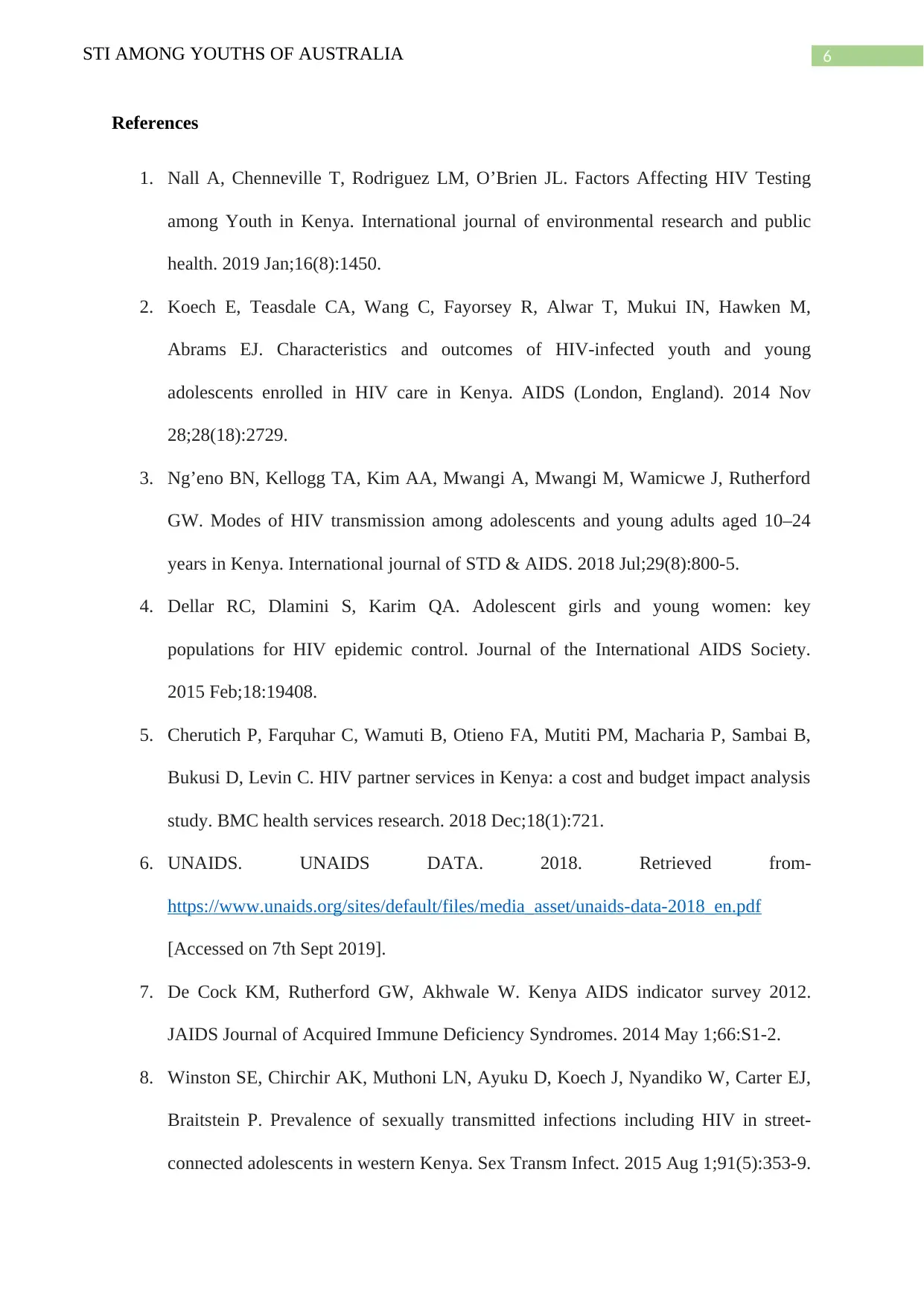
6STI AMONG YOUTHS OF AUSTRALIA
References
1. Nall A, Chenneville T, Rodriguez LM, O’Brien JL. Factors Affecting HIV Testing
among Youth in Kenya. International journal of environmental research and public
health. 2019 Jan;16(8):1450.
2. Koech E, Teasdale CA, Wang C, Fayorsey R, Alwar T, Mukui IN, Hawken M,
Abrams EJ. Characteristics and outcomes of HIV-infected youth and young
adolescents enrolled in HIV care in Kenya. AIDS (London, England). 2014 Nov
28;28(18):2729.
3. Ng’eno BN, Kellogg TA, Kim AA, Mwangi A, Mwangi M, Wamicwe J, Rutherford
GW. Modes of HIV transmission among adolescents and young adults aged 10–24
years in Kenya. International journal of STD & AIDS. 2018 Jul;29(8):800-5.
4. Dellar RC, Dlamini S, Karim QA. Adolescent girls and young women: key
populations for HIV epidemic control. Journal of the International AIDS Society.
2015 Feb;18:19408.
5. Cherutich P, Farquhar C, Wamuti B, Otieno FA, Mutiti PM, Macharia P, Sambai B,
Bukusi D, Levin C. HIV partner services in Kenya: a cost and budget impact analysis
study. BMC health services research. 2018 Dec;18(1):721.
6. UNAIDS. UNAIDS DATA. 2018. Retrieved from-
https://www.unaids.org/sites/default/files/media_asset/unaids-data-2018_en.pdf
[Accessed on 7th Sept 2019].
7. De Cock KM, Rutherford GW, Akhwale W. Kenya AIDS indicator survey 2012.
JAIDS Journal of Acquired Immune Deficiency Syndromes. 2014 May 1;66:S1-2.
8. Winston SE, Chirchir AK, Muthoni LN, Ayuku D, Koech J, Nyandiko W, Carter EJ,
Braitstein P. Prevalence of sexually transmitted infections including HIV in street-
connected adolescents in western Kenya. Sex Transm Infect. 2015 Aug 1;91(5):353-9.
References
1. Nall A, Chenneville T, Rodriguez LM, O’Brien JL. Factors Affecting HIV Testing
among Youth in Kenya. International journal of environmental research and public
health. 2019 Jan;16(8):1450.
2. Koech E, Teasdale CA, Wang C, Fayorsey R, Alwar T, Mukui IN, Hawken M,
Abrams EJ. Characteristics and outcomes of HIV-infected youth and young
adolescents enrolled in HIV care in Kenya. AIDS (London, England). 2014 Nov
28;28(18):2729.
3. Ng’eno BN, Kellogg TA, Kim AA, Mwangi A, Mwangi M, Wamicwe J, Rutherford
GW. Modes of HIV transmission among adolescents and young adults aged 10–24
years in Kenya. International journal of STD & AIDS. 2018 Jul;29(8):800-5.
4. Dellar RC, Dlamini S, Karim QA. Adolescent girls and young women: key
populations for HIV epidemic control. Journal of the International AIDS Society.
2015 Feb;18:19408.
5. Cherutich P, Farquhar C, Wamuti B, Otieno FA, Mutiti PM, Macharia P, Sambai B,
Bukusi D, Levin C. HIV partner services in Kenya: a cost and budget impact analysis
study. BMC health services research. 2018 Dec;18(1):721.
6. UNAIDS. UNAIDS DATA. 2018. Retrieved from-
https://www.unaids.org/sites/default/files/media_asset/unaids-data-2018_en.pdf
[Accessed on 7th Sept 2019].
7. De Cock KM, Rutherford GW, Akhwale W. Kenya AIDS indicator survey 2012.
JAIDS Journal of Acquired Immune Deficiency Syndromes. 2014 May 1;66:S1-2.
8. Winston SE, Chirchir AK, Muthoni LN, Ayuku D, Koech J, Nyandiko W, Carter EJ,
Braitstein P. Prevalence of sexually transmitted infections including HIV in street-
connected adolescents in western Kenya. Sex Transm Infect. 2015 Aug 1;91(5):353-9.
Paraphrase This Document
Need a fresh take? Get an instant paraphrase of this document with our AI Paraphraser
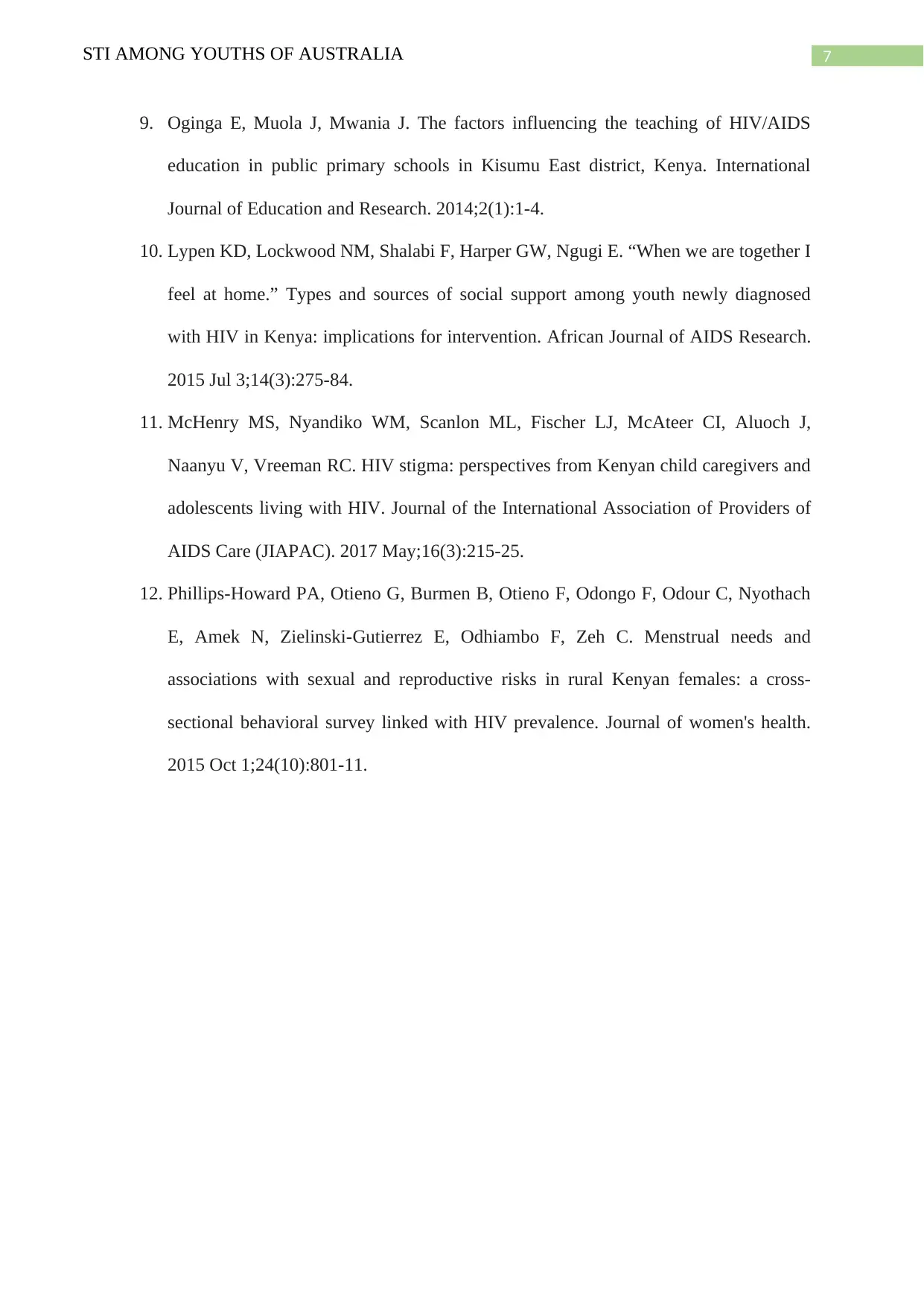
7STI AMONG YOUTHS OF AUSTRALIA
9. Oginga E, Muola J, Mwania J. The factors influencing the teaching of HIV/AIDS
education in public primary schools in Kisumu East district, Kenya. International
Journal of Education and Research. 2014;2(1):1-4.
10. Lypen KD, Lockwood NM, Shalabi F, Harper GW, Ngugi E. “When we are together I
feel at home.” Types and sources of social support among youth newly diagnosed
with HIV in Kenya: implications for intervention. African Journal of AIDS Research.
2015 Jul 3;14(3):275-84.
11. McHenry MS, Nyandiko WM, Scanlon ML, Fischer LJ, McAteer CI, Aluoch J,
Naanyu V, Vreeman RC. HIV stigma: perspectives from Kenyan child caregivers and
adolescents living with HIV. Journal of the International Association of Providers of
AIDS Care (JIAPAC). 2017 May;16(3):215-25.
12. Phillips-Howard PA, Otieno G, Burmen B, Otieno F, Odongo F, Odour C, Nyothach
E, Amek N, Zielinski-Gutierrez E, Odhiambo F, Zeh C. Menstrual needs and
associations with sexual and reproductive risks in rural Kenyan females: a cross-
sectional behavioral survey linked with HIV prevalence. Journal of women's health.
2015 Oct 1;24(10):801-11.
9. Oginga E, Muola J, Mwania J. The factors influencing the teaching of HIV/AIDS
education in public primary schools in Kisumu East district, Kenya. International
Journal of Education and Research. 2014;2(1):1-4.
10. Lypen KD, Lockwood NM, Shalabi F, Harper GW, Ngugi E. “When we are together I
feel at home.” Types and sources of social support among youth newly diagnosed
with HIV in Kenya: implications for intervention. African Journal of AIDS Research.
2015 Jul 3;14(3):275-84.
11. McHenry MS, Nyandiko WM, Scanlon ML, Fischer LJ, McAteer CI, Aluoch J,
Naanyu V, Vreeman RC. HIV stigma: perspectives from Kenyan child caregivers and
adolescents living with HIV. Journal of the International Association of Providers of
AIDS Care (JIAPAC). 2017 May;16(3):215-25.
12. Phillips-Howard PA, Otieno G, Burmen B, Otieno F, Odongo F, Odour C, Nyothach
E, Amek N, Zielinski-Gutierrez E, Odhiambo F, Zeh C. Menstrual needs and
associations with sexual and reproductive risks in rural Kenyan females: a cross-
sectional behavioral survey linked with HIV prevalence. Journal of women's health.
2015 Oct 1;24(10):801-11.
1 out of 8
Related Documents
Your All-in-One AI-Powered Toolkit for Academic Success.
+13062052269
info@desklib.com
Available 24*7 on WhatsApp / Email
![[object Object]](/_next/static/media/star-bottom.7253800d.svg)
Unlock your academic potential
Copyright © 2020–2025 A2Z Services. All Rights Reserved. Developed and managed by ZUCOL.





